Disentangling Long Trajectory Contributions in Two-Colour High Harmonic Generation
Abstract
:1. Introduction
2. Two-Colour HHG
3. CTMC Method
4. Macroscopic Propagation
5. CTMC Simulations
5.1. Displacement Gate
5.2. Long Trajectories Contribution
6. Conclusions
Acknowledgments
Author Contributions
Conflicts of Interest
Abbreviations
| HHG | High Harmonic Generation |
| SFA | Strong Field Approximation |
| CTMC | Classical Trajectory Monte Carlo Simulation |
| ADK | Ammosov Delone Krainov |
| TIPIS | Tunnel Ionisation in Parabolic Coordinates with Induced Polarisation and Stark Shift |
| XUV | Extreme Ultra-Violet |
| IR | Infrared |
| FWHM | Full Width Half Maximum |
References
- McPherson, A.; Gibson, G.; Jara, H.; Johann, U.; Luk, T.S.; McIntyre, I.A.; Boyer, K.; Rhodes, C.K. Studies of multiphoton production of vacuum-ultraviolet radiation in the rare gases. J. Opt. Soc. Am. B 1987, 4, 595. [Google Scholar] [CrossRef]
- Ferray, M.; L’Huillier, A.; Li, X.F.; Lompre, L.A.; Mainfray, G.; Manus, C. Multiple-harmonic conversion of 1064 nm radiation in rare gases. J. Phys. B At. Mol. Opt. Phys. 1988, 21, L31–L35. [Google Scholar] [CrossRef]
- Gaumnitz, T.; Jain, A.; Pertot, Y.; Huppert, M.; Jordan, I.; Ardana-Lamas, F.; Wörner, H.J. Streaking of 43-attosecond soft-X-ray pulses generated by a passively CEP-stable mid-infrared driver. Opt. Express 2017, 25, 27506. [Google Scholar] [CrossRef] [PubMed]
- Muller, H. Reconstruction of attosecond harmonic beating by interference of two-photon transitions. Appl. Phys. B 2002, 74, s17–s21. [Google Scholar] [CrossRef]
- Itatani, J.; Quéré, F.; Yudin, G.L.; Ivanov, M.Y.; Krausz, F.; Corkum, P.B. Attosecond Streak Camera. Phys. Rev. Lett. 2002, 88, 173903. [Google Scholar] [CrossRef] [PubMed]
- Krausz, F.; Ivanov, M. Attosecond physics. Rev. Mod. Phys. 2009, 81, 163–234. [Google Scholar] [CrossRef]
- Gallmann, L.; Cirelli, C.; Keller, U. Attosecond science: Recent highlights and future trends. Ann. Rev. Phys. Chem. 2012, 63, 447–469. [Google Scholar] [CrossRef] [PubMed]
- Krause, J.L.; Schafer, K.J.; Kulander, K.C. High-order harmonic generation from atoms and ions in the high intensity regime. Phys. Rev. Lett. 1992, 68, 3535–3538. [Google Scholar] [CrossRef] [PubMed]
- Schafer, K.J.; Yang, B.; DiMauro, L.F.; Kulander, K.C. Above threshold ionization beyond the high harmonic cutoff. Phys. Rev. Lett. 1993, 70, 1599–1602. [Google Scholar] [CrossRef] [PubMed]
- Corkum, P.B. Plasma perspective on strong field multiphoton ionization. Phys. Rev. Lett. 1993, 71, 1994–1997. [Google Scholar] [CrossRef] [PubMed]
- Antoine, P.; L’Huillier, A.; Lewenstein, M. Attosecond Pulse Trains Using High–Order Harmonics. Phys. Rev. Lett. 1996, 77, 1234–1237. [Google Scholar] [CrossRef] [PubMed]
- Lindner, F.; Stremme, W.; Schätzel, M.G.; Grasbon, F.; Paulus, G.G.; Walther, H.; Hartmann, R.; Strüder, L. High-order harmonic generation at a repetition rate of 100 kHz. Phys. Rev. A 2003, 68, 013814. [Google Scholar] [CrossRef]
- Heyl, C.M.; Güdde, J.; L’Huillier, A.; Höfer, U. High-order harmonic generation with μJ laser pulses at high repetition rates. J. Phys. B At. Mol. Opt. Phys. 2012, 45, 074020. [Google Scholar] [CrossRef]
- Lyngå, C.; Gaarde, M.B.; Delfin, C.; Bellini, M.; Hänsch, T.W.; L’ Huillier, A.; Wahlström, C.G. Temporal coherence of high-order harmonics. Phys. Rev. A 1999, 60, 4823–4830. [Google Scholar] [CrossRef]
- Itatani, J.; Levesque, J.; Zeidler, D.; Niikura, H.; Pépin, H.; Kieffer, J.C.; Corkum, P.B.; Villeneuve, D.M. Tomographic imaging of molecular orbitals. Nature 2004, 432, 867–871. [Google Scholar] [CrossRef] [PubMed]
- Baker, S.; Robinson, J.S.; Haworth, C.A.; Teng, H.; Smith, R.A.; Chirila, C.C.; Lein, M.; Tisch, J.W.G.; Marangos, J.P. Probing Proton Dynamics in Molecules on an Attosecond Time Scale. Science 2006, 312, 424–427. [Google Scholar] [CrossRef] [PubMed]
- Dudovich, N.; Levesque, J.; Smirnova, O.; Zeidler, D.; Comtois, D.; Ivanov, M.Y.; Villeneuve, D.M.; Corkum, P.B. Attosecond Temporal Gating with Elliptically Polarized Light. Phys. Rev. Lett. 2006, 97, 253903. [Google Scholar] [CrossRef] [PubMed]
- Shafir, D.; Soifer, H.; Bruner, B.D.; Dagan, M.; Mairesse, Y.; Patchkovskii, S.; Ivanov, M.Y.; Smirnova, O.; Dudovich, N. Resolving the time when an electron exits a tunnelling barrier. Nature 2012, 485, 343–346. [Google Scholar] [CrossRef] [PubMed]
- Ivanov, M.Y.; Spanner, M.; Smirnova, O. Anatomy of strong field ionization. J. Mod. Opt. 2005, 52, 165–184. [Google Scholar] [CrossRef]
- Reiss, H.R. The tunnelling model of laser-induced ionization and its failure at low frequencies. J. Phys. B At. Mol. Opt. Phys. 2014, 47, 204006. [Google Scholar] [CrossRef]
- Majety, V.P.; Scrinzi, A. Absence of electron correlation effects in the Helium attoclock setting. J. Mod. Opt. 2017, 0340, 1–5. [Google Scholar] [CrossRef]
- Lewenstein, M.; Balcou, P.; Ivanov, M.Y.; L’Huillier, A.; Corkum, P.B. Theory of high-harmonic generation by low-frequency laser fields. Phys. Rev. A 1994, 49, 2117–2132. [Google Scholar] [CrossRef] [PubMed]
- Zaïr, A.; Holler, M.; Guandalini, A.; Schapper, F.; Biegert, J.; Gallmann, L.; Keller, U.; Wyatt, A.S.; Monmayrant, A.; Walmsley, I.A.; et al. Quantum Path Interferences in High-Order Harmonic Generation. Phys. Rev. Lett. 2008, 100, 143902. [Google Scholar] [CrossRef] [PubMed]
- Auguste, T.; Salières, P.; Wyatt, A.S.; Monmayrant, A.; Walmsley, I.A.; Cormier, E.; Zaïr, A.; Holler, M.; Guandalini, A.; Schapper, F.; et al. Theoretical and experimental analysis of quantum path interferences in high-order harmonic generation. Phys. Rev. A 2009, 80, 033817. [Google Scholar] [CrossRef]
- Holler, M.; Zaïr, A.; Schapper, F.; Auguste, T.; Cormier, E.; Wyatt, A.; Monmayrant, A.; Walmsley, I.A.; Gallmann, L.; Salières, P.; et al. Ionization effects on spectral signatures of quantum-path interference in high-harmonic generation. Opt. Express 2009, 17, 5716. [Google Scholar] [CrossRef] [PubMed]
- Kurz, H.G.; Kretschmar, M.; Binhammer, T.; Nagy, T.; Ristau, D.; Lein, M.; Morgner, U.; Kovačev, M. Revealing the Microscopic Real-Space Excursion of a Laser-Driven Electron. Phys. Rev. X 2016, 6, 031029. [Google Scholar] [CrossRef]
- Balcou, P.; Salières, P.; L’Huillier, A.; Lewenstein, M. Generalized phase-matching conditions for high harmonics: The role of field-gradient forces. Phys. Rev. A 1997, 55, 3204–3210. [Google Scholar] [CrossRef]
- Soifer, H.; Bruner, B.D.; Negro, M.; Devetta, M.; Faccialà, D.; Vozzi, C.; Silvestri, S.D.; Stagira, S.; Dudovich, N. Studying the universality of field induced tunnel ionization times via high-order harmonic spectroscopy. J. Phys. B At. Mol. Opt. Phys. 2014, 47, 204029. [Google Scholar] [CrossRef]
- Bruner, B.D.; Soifer, H.; Shafir, D.; Serbinenko, V.; Smirnova, O.; Dudovich, N. Multidimensional high harmonic spectroscopy. J. Phys. B At. Mol. Opt. Phys. 2015, 48, 174006. [Google Scholar] [CrossRef]
- Ammosov, M.V.; Delone, N.B.; Krainov, V.P. Tunnel ionization of complex atoms and atomic ions by an alternating electromagnetic field. Sov. Phys. JETP 1986, 64, 1191–1194. [Google Scholar]
- Delone, N.B.; Krainov, V.P. Energy and angular electron spectra for the tunnel ionization of atoms by strong low-frequency radiation. J. Opt. Soc. Am. B 1991, 8, 1207–1211. [Google Scholar] [CrossRef]
- Perelomov, A.M.; Popov, V.S.; Terent’ev, M.V. Ionization of Atoms in an Alternating Electric Field: II. Sov. Phys. JETP 1967, 24, 207–217. [Google Scholar]
- Mur, V.; Popruzhenko, S.; Popov, V. Energy and momentum spectra of photoelectrons under conditions of ionization by strong laser radiation (The case of elliptic polarization). Sov. Phys. JETP 2001, 92, 777–788. [Google Scholar] [CrossRef]
- Zhao, J.; Lein, M. Determination of Ionization and Tunneling Times in High-Order Harmonic Generation. Phys. Rev. Lett. 2013, 111, 043901. [Google Scholar] [CrossRef] [PubMed]
- Hofmann, C.; Landsman, A.S.; Cirelli, C.; Pfeiffer, A.N.; Keller, U. Comparison of different approaches to the longitudinal momentum spread after tunnel ionization. J. Phys. B At. Mol. Opt. Phys. 2013, 46, 125601. [Google Scholar] [CrossRef]
- Hofmann, C.; Zimmermann, T.; Zielinski, A.; Landsman, A.S. Non-adiabatic imprints on the electron wave packet in strong field ionization with circular polarization. New J. Phys. 2016, 18, 043011. [Google Scholar] [CrossRef]
- Landau, L.D.; Lifshitz, E.M. Quantum Mechanics, 2nd ed.; Pergamon Press Ltd.: Oxford, UK, 1965. [Google Scholar]
- Fu, L.B.; Liu, J.; Chen, J.; Chen, S.G. Classical collisional trajectories as the source of strong-field double ionization of helium in the knee regime. Phys. Rev. A 2001, 63, 043416. [Google Scholar] [CrossRef]
- Pfeiffer, A.N.; Cirelli, C.; Smolarski, M.; Dimitrovski, D.; Abu-samha, M.; Madsen, L.B.; Keller, U. Attoclock reveals natural coordinates of the laser-induced tunnelling current flow in atoms. Nat. Phys. 2012, 8, 76–80. [Google Scholar] [CrossRef]
- Shvetsov-Shilovski, N.I.; Dimitrovski, D.; Madsen, L.B. Ionization in elliptically polarized pulses: Multielectron polarization effects and asymmetry of photoelectron momentum distributions. Phys. Rev. A 2012, 85, 23428. [Google Scholar] [CrossRef]
- Hofmann, C. Attosecond Electron Dynamics in Strong-Field Ionization. Ph.D. Thesis, ETH Zurich, Zurich, Switzerland, 2016. Available online: http://dx.doi.org/10.3929/ethz-a-010859956 (accessed on 18 January 2018).
- Xiong, W.H.; Geng, J.W.; Gong, Q.; Peng, L.Y. Half-cycle cutoff in near-threshold harmonic generation. New J. Phys. 2015, 17, 123020. [Google Scholar] [CrossRef]
- Tiedemann, D.; Stiebing, K.; Winters, D.; Quint, W.; Varentsov, V.; Warczak, A.; Malarz, A.; Stöhlker, T. A pulsed supersonic gas jet target for precision spectroscopy at the HITRAP facility at GSI. Nucl. Instrum. Methods Phys. Res. Sect. A Accel. Spectrom. Detect. Assoc. Equip. 2014, 764, 387–393. [Google Scholar] [CrossRef]
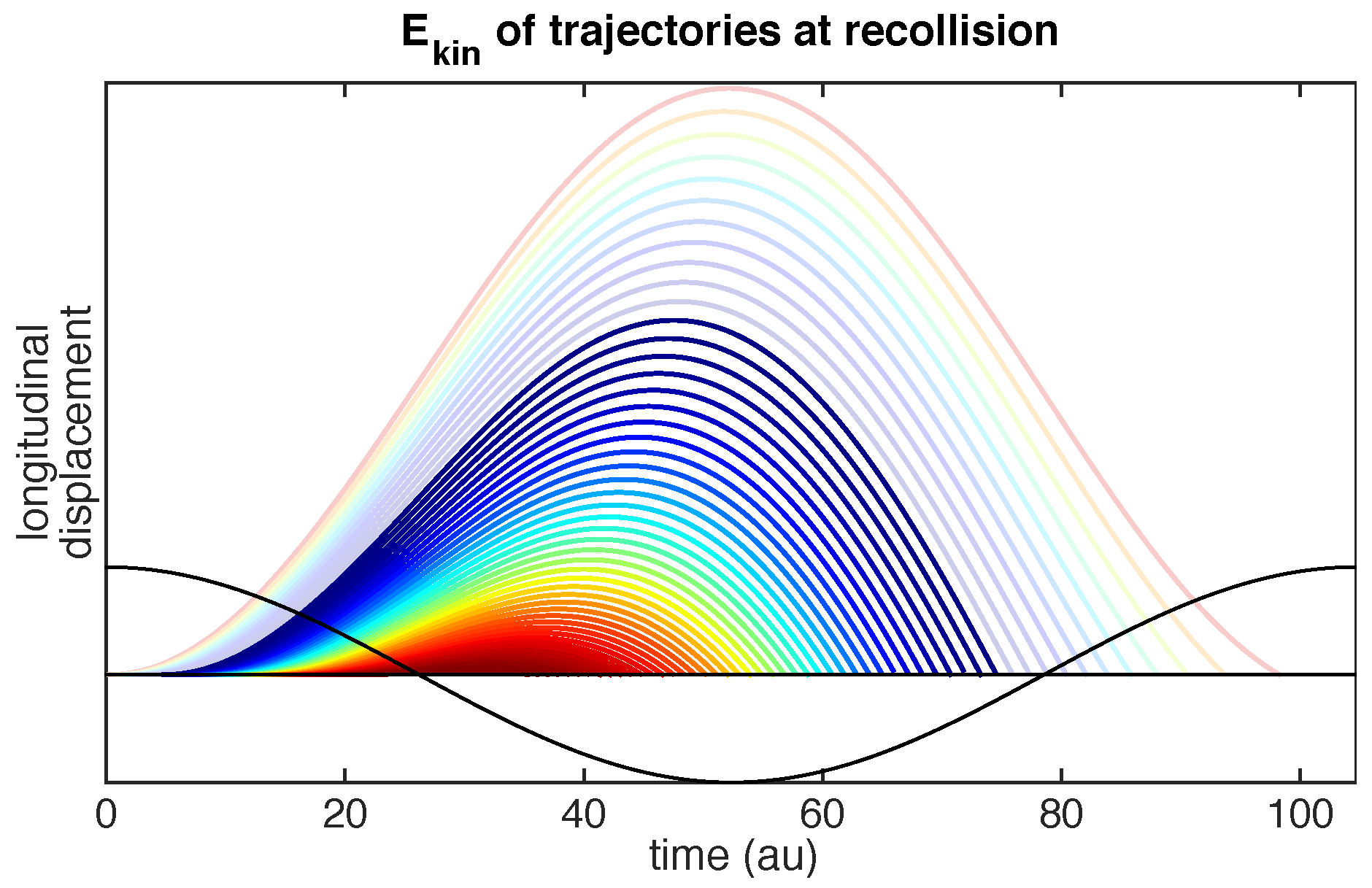
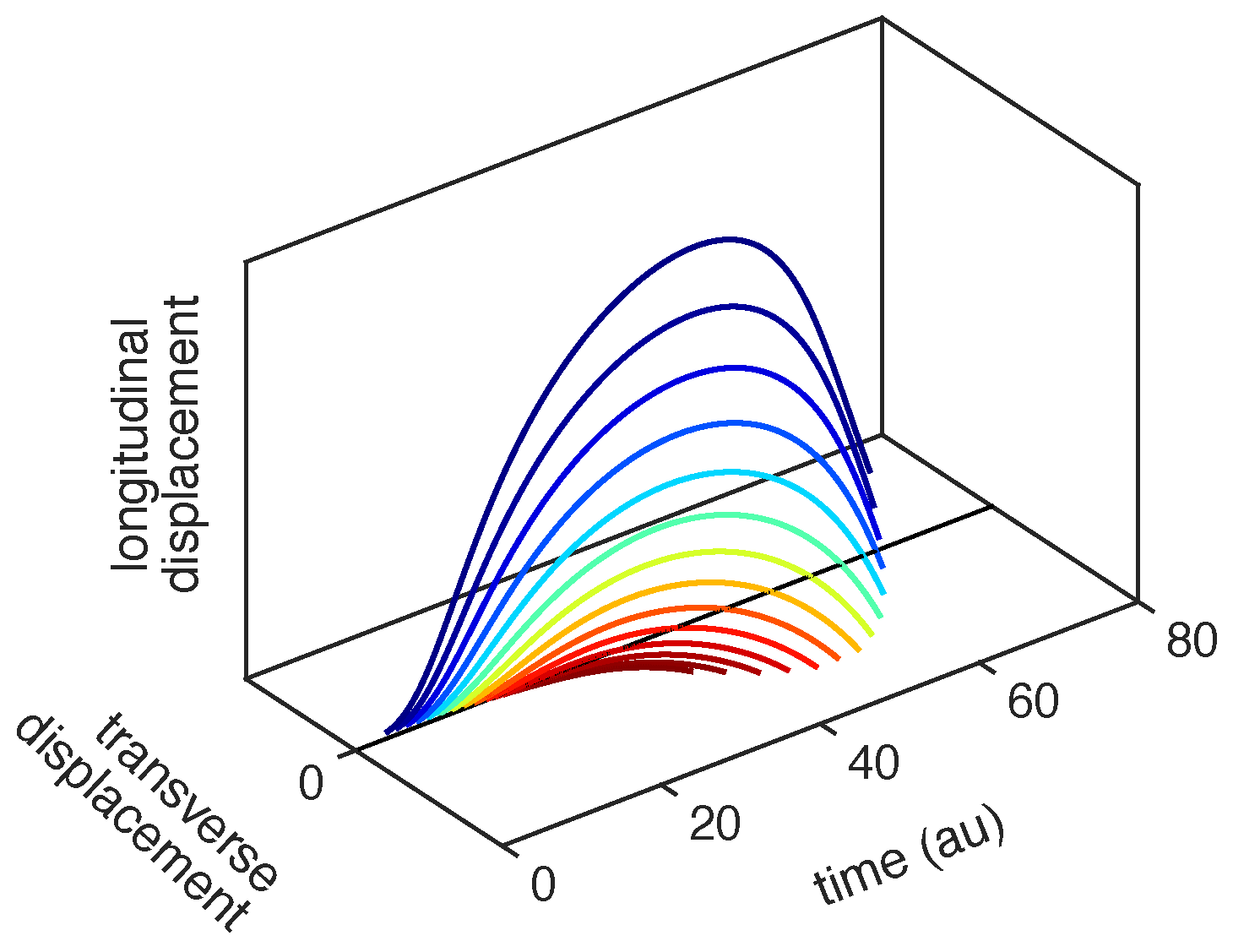
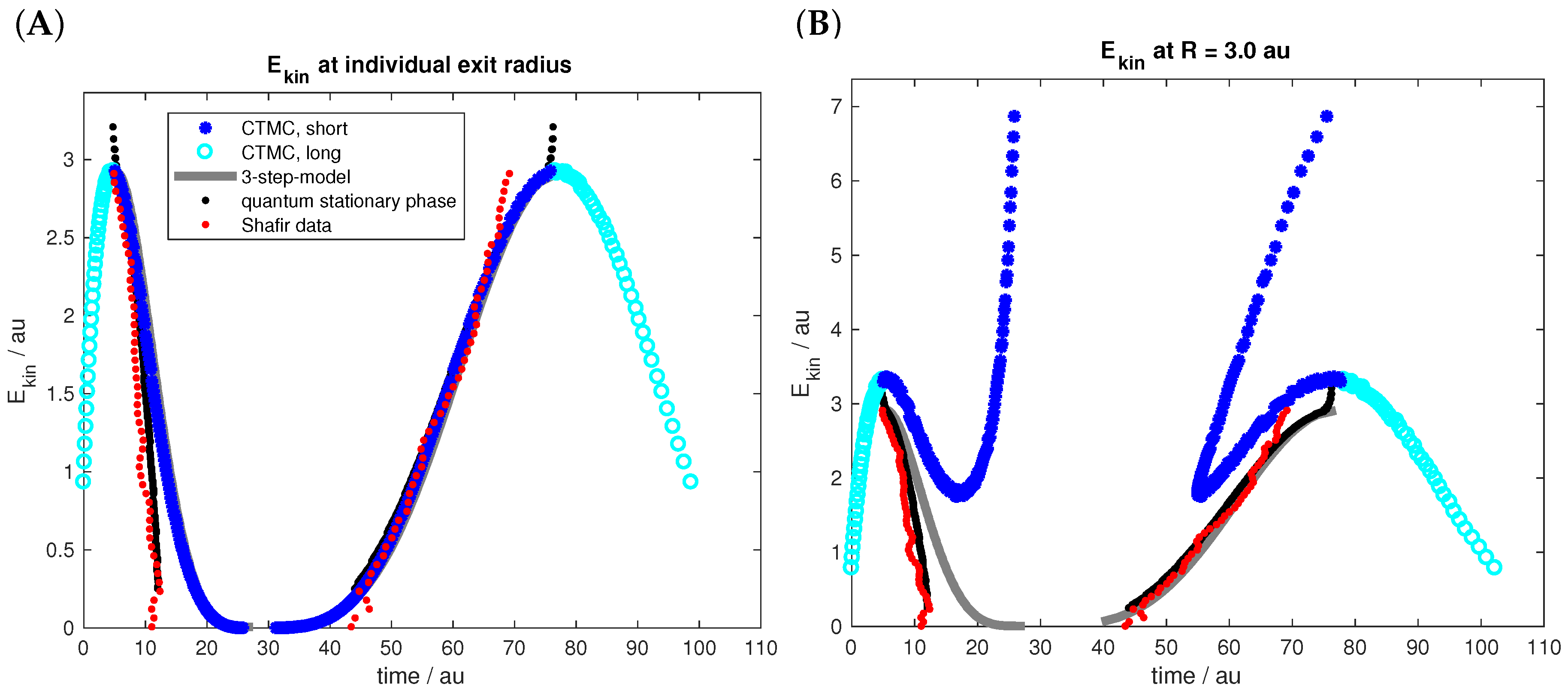
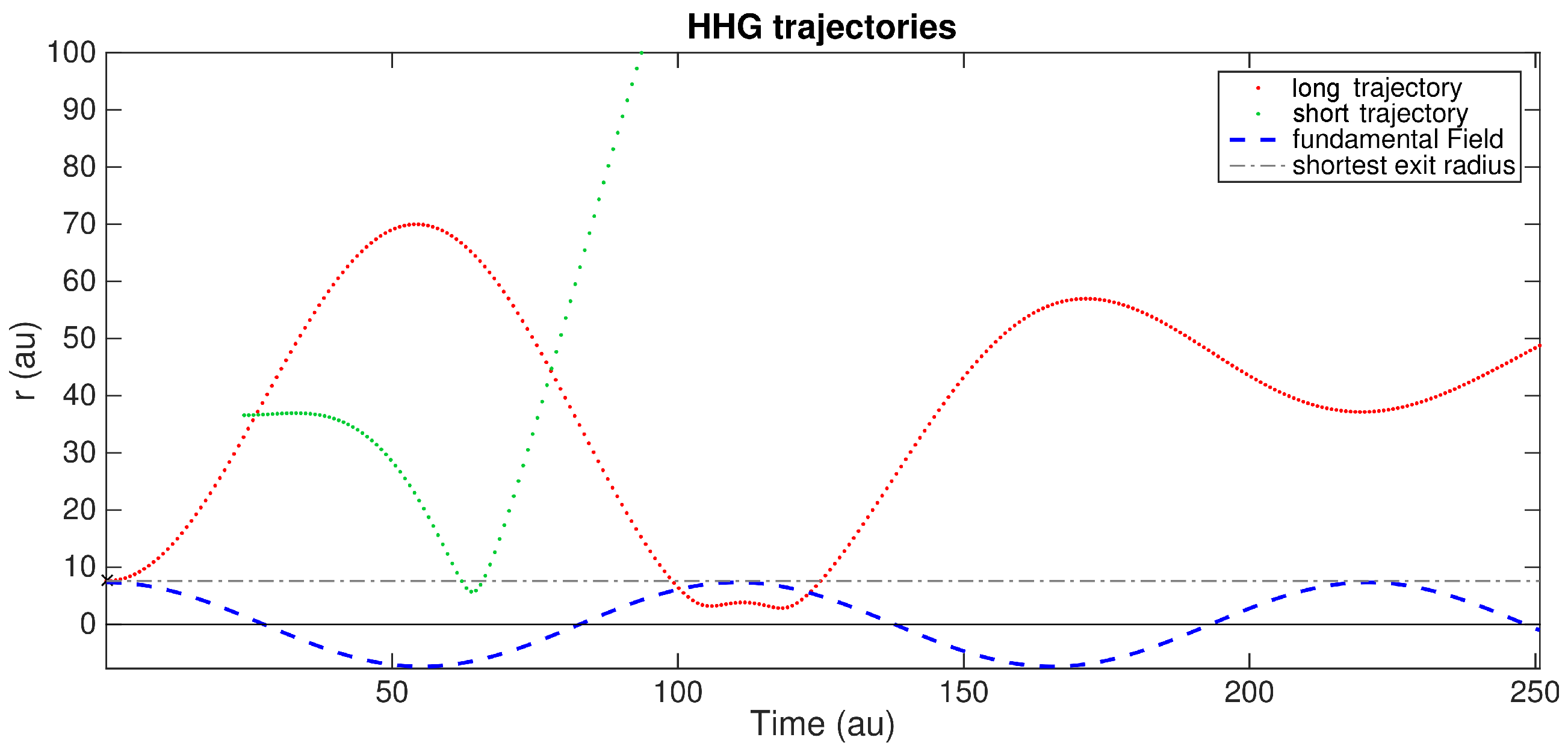

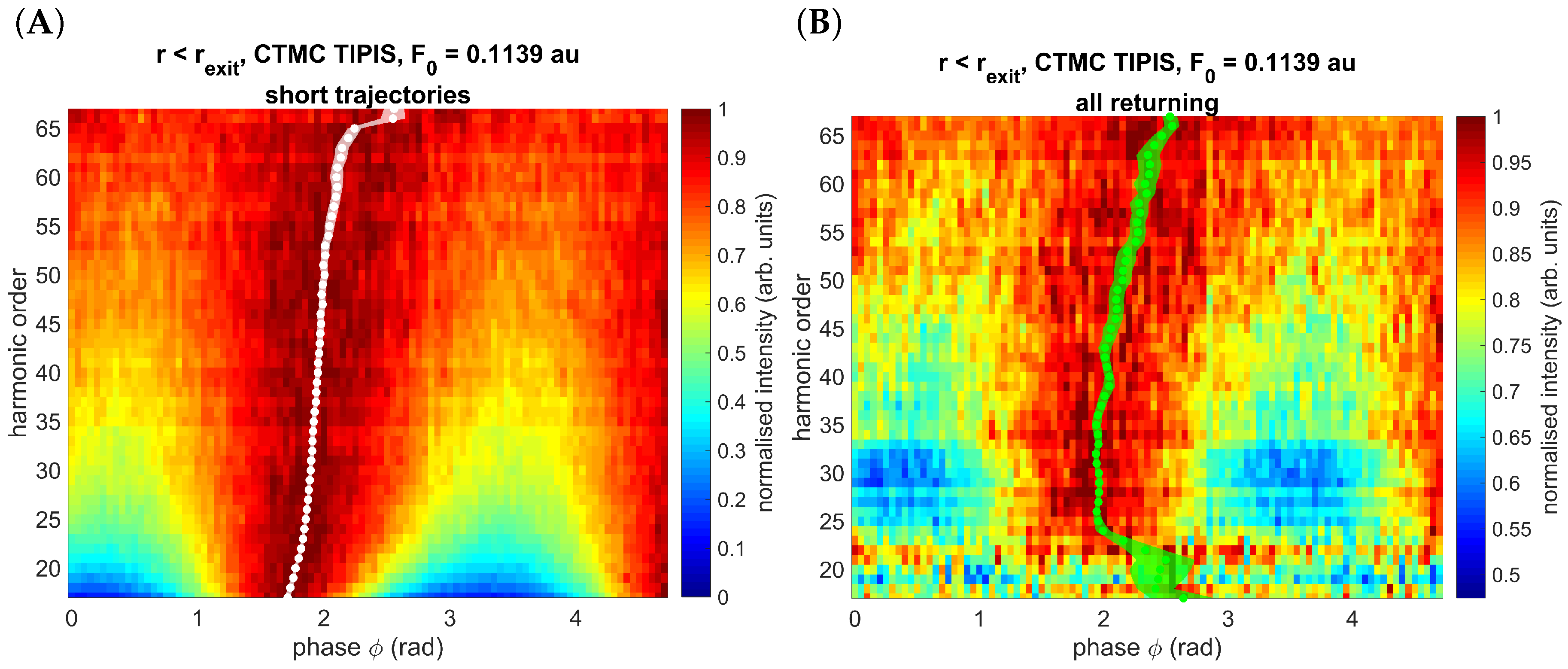
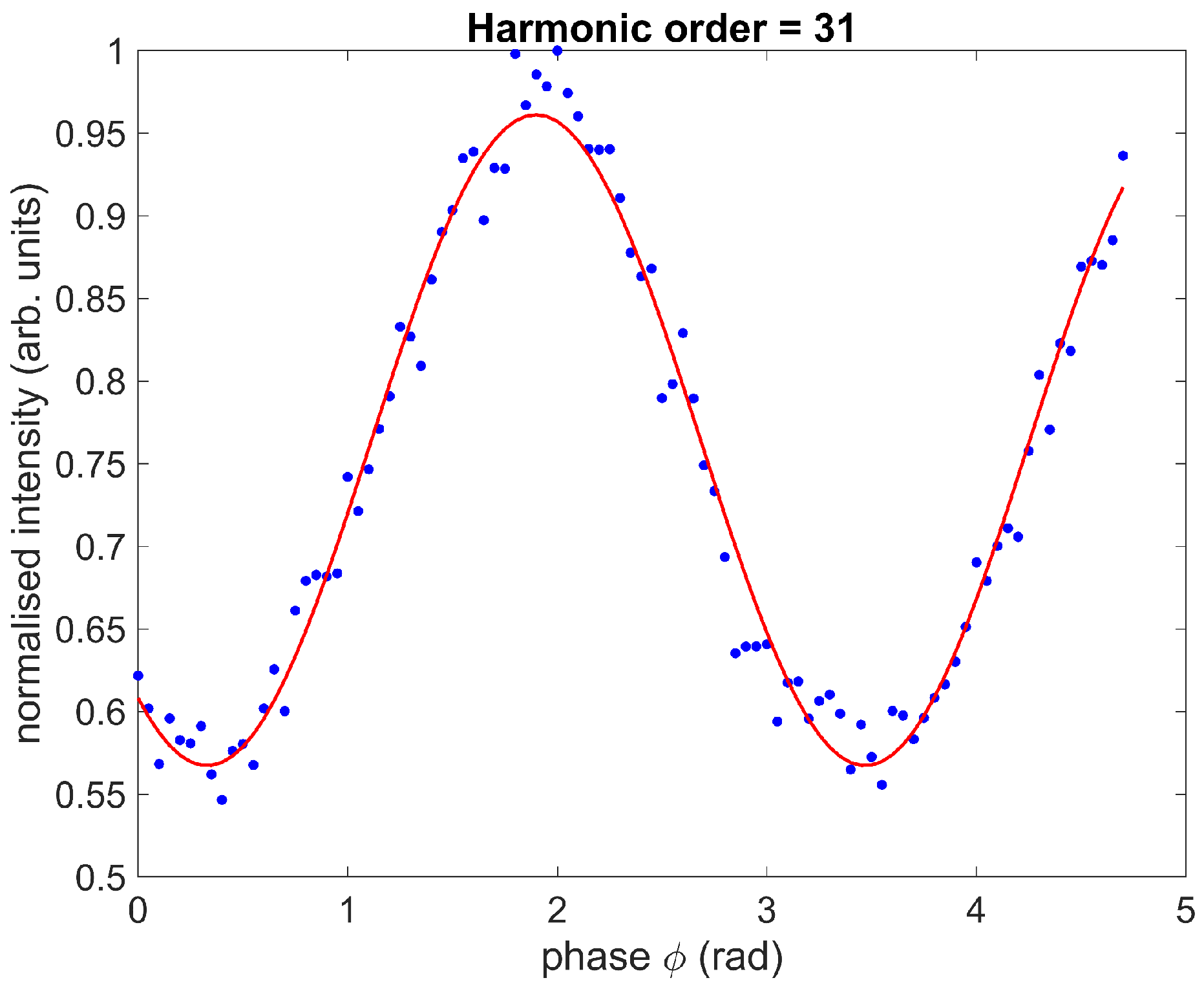
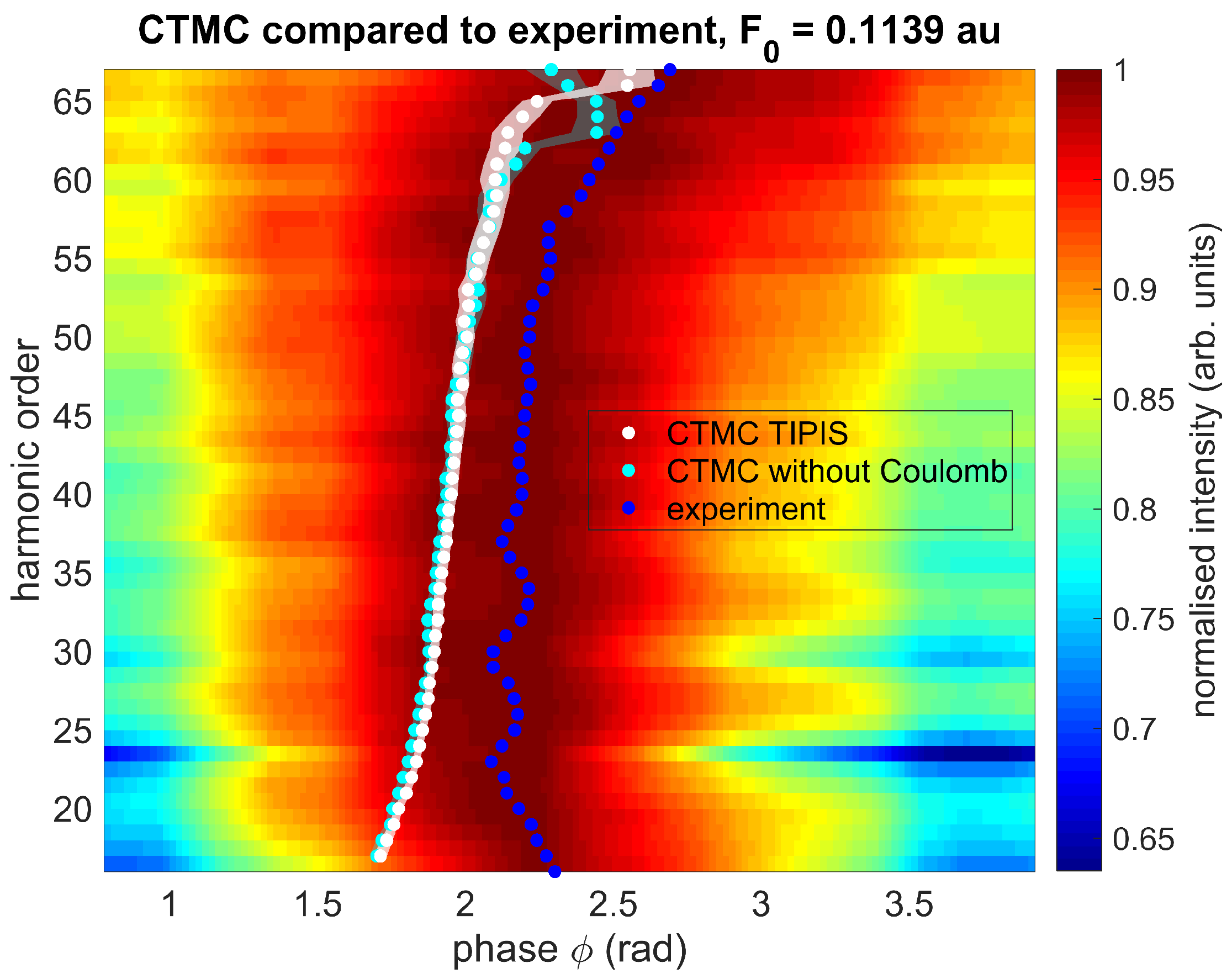
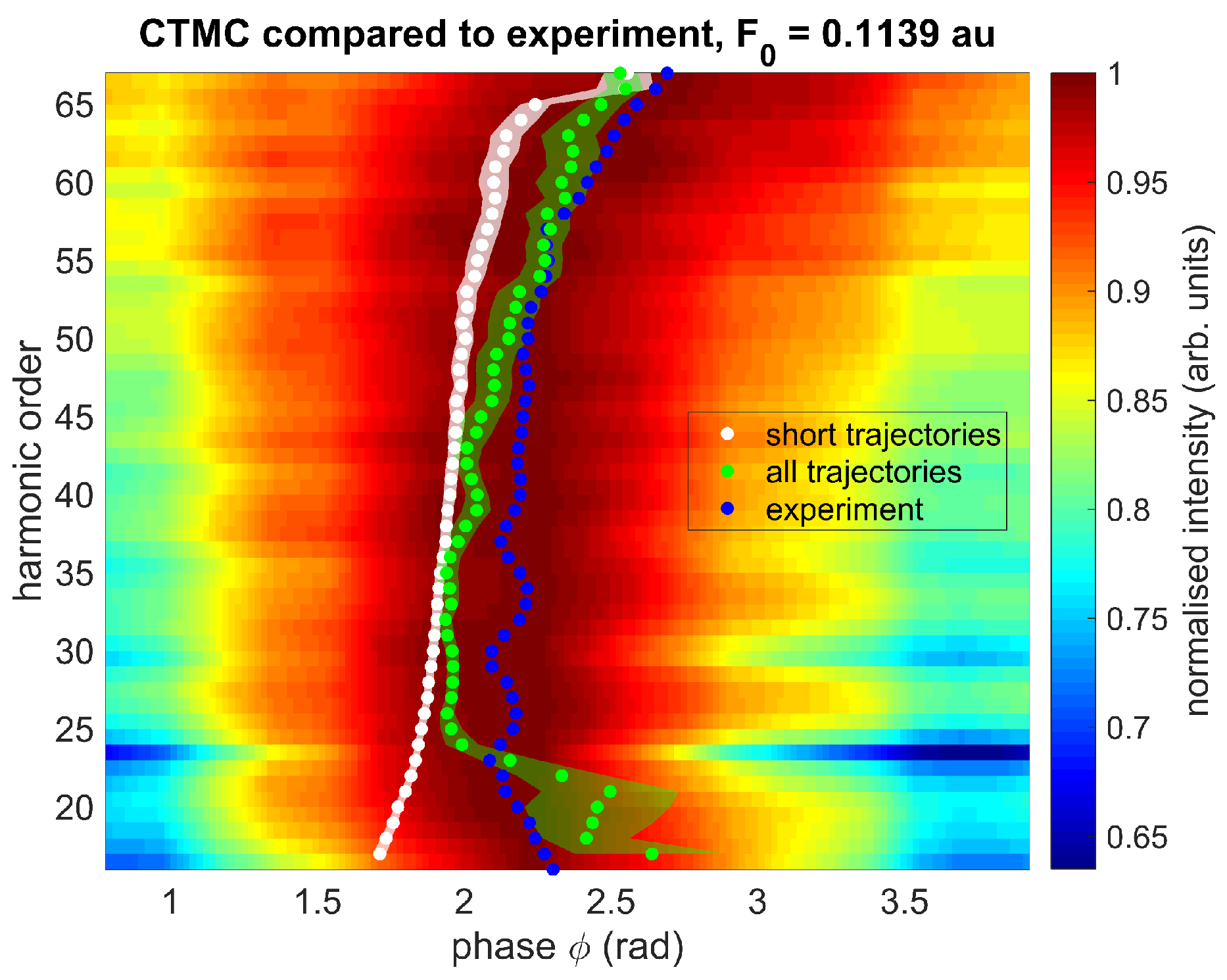
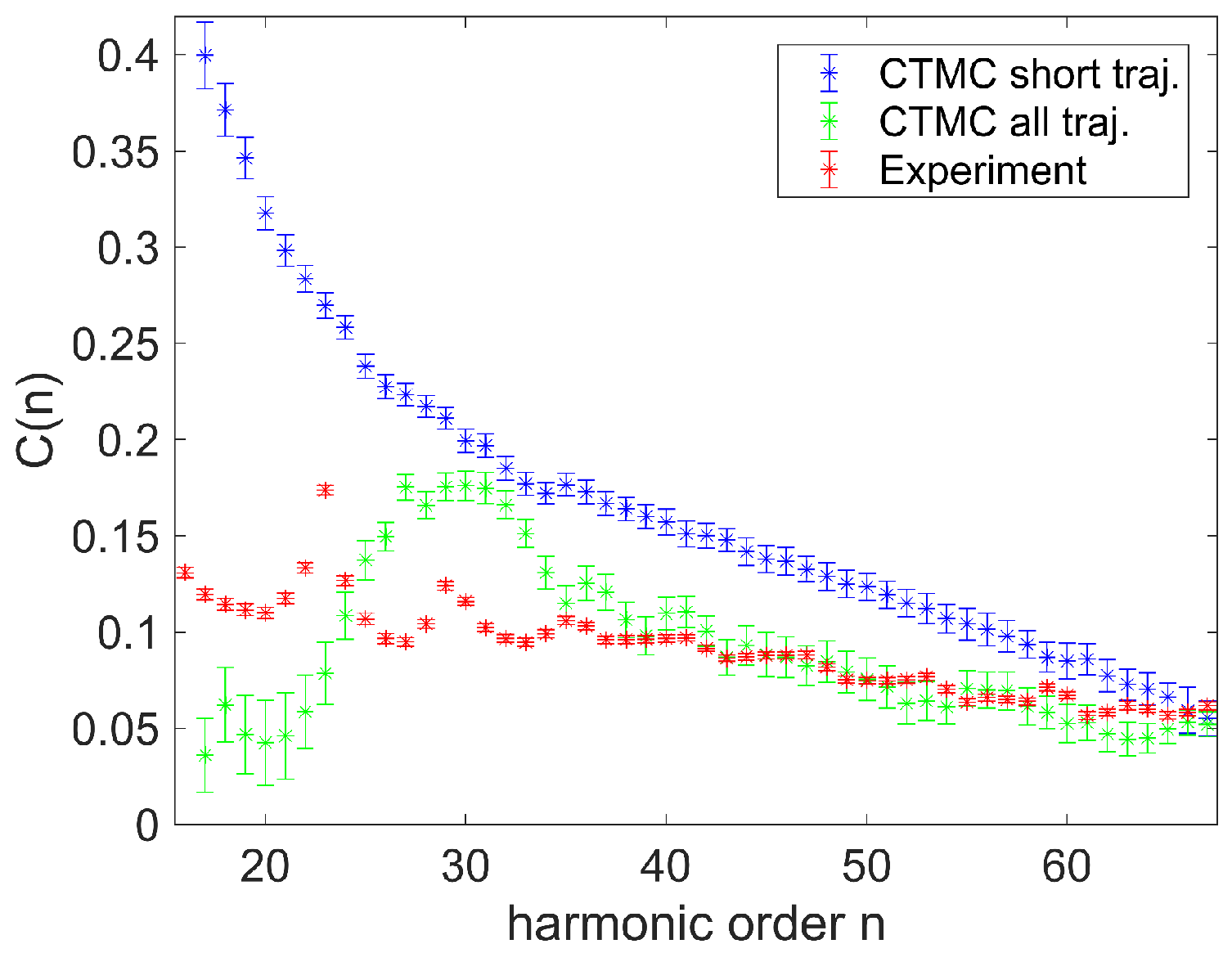
| z | longitudinal position in direction of beam propagation |
| r | radial position away from the beam axis |
| exit time | |
| return time | |
| excursion time | |
| radiated harmonic | |
| fundamental Gaussian beam | |
| classical action for electron wave packet propagation | |
| intrinsic atomic phase | |
| N | total number of interacting targets along the axis |
| j | gas jet diameter |
© 2018 by the authors. Licensee MDPI, Basel, Switzerland. This article is an open access article distributed under the terms and conditions of the Creative Commons Attribution (CC BY) license (http://creativecommons.org/licenses/by/4.0/).
Share and Cite
Hofmann, C.; Landsman, A.S.; Keller, U. Disentangling Long Trajectory Contributions in Two-Colour High Harmonic Generation. Appl. Sci. 2018, 8, 341. https://doi.org/10.3390/app8030341
Hofmann C, Landsman AS, Keller U. Disentangling Long Trajectory Contributions in Two-Colour High Harmonic Generation. Applied Sciences. 2018; 8(3):341. https://doi.org/10.3390/app8030341
Chicago/Turabian StyleHofmann, Cornelia, Alexandra S. Landsman, and Ursula Keller. 2018. "Disentangling Long Trajectory Contributions in Two-Colour High Harmonic Generation" Applied Sciences 8, no. 3: 341. https://doi.org/10.3390/app8030341
APA StyleHofmann, C., Landsman, A. S., & Keller, U. (2018). Disentangling Long Trajectory Contributions in Two-Colour High Harmonic Generation. Applied Sciences, 8(3), 341. https://doi.org/10.3390/app8030341





